2008 KIA Sportage ECU
[x] Cancel search: ECUPage 54 of 350
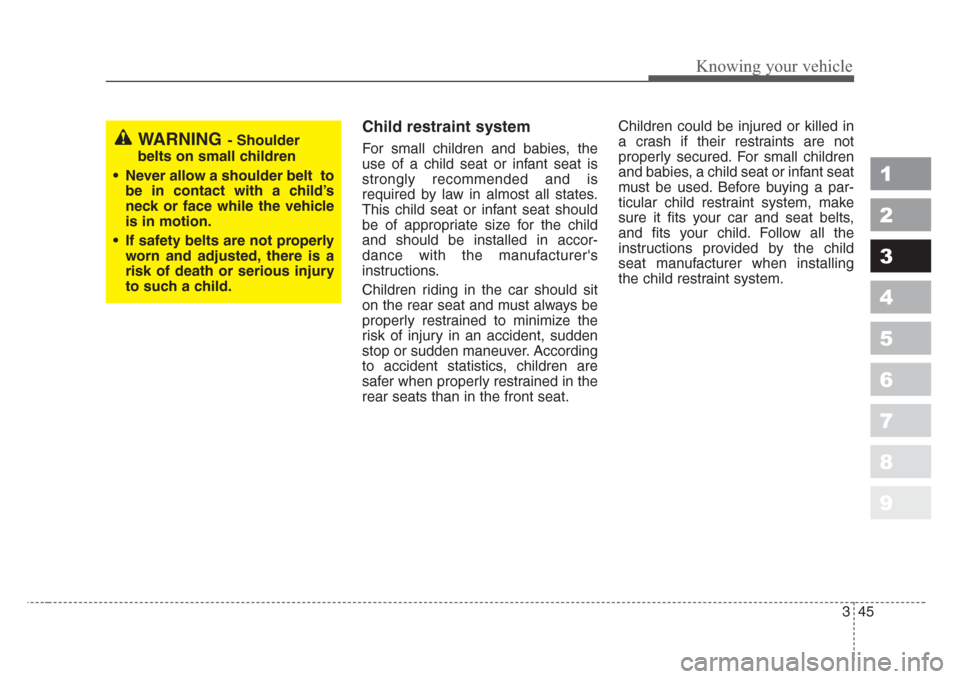
345
Knowing your vehicle
1
2
3
4
5
6
7
8
9
Child restraint system
For small children and babies, the
use of a child seat or infant seat is
strongly recommended and is
required by law in almost all states.
This child seat or infant seat should
be of appropriate size for the child
and should be installed in accor-
dance with the manufacturer's
instructions.
Children riding in the car should sit
on the rear seat and must always be
properly restrained to minimize the
risk of injury in an accident, sudden
stop or sudden maneuver. According
to accident statistics, children are
safer when properly restrained in the
rear seats than in the front seat.Children could be injured or killed in
a crash if their restraints are not
properly secured. For small children
and babies, a child seat or infant seat
must be used. Before buying a par-
ticular child restraint system, make
sure it fits your car and seat belts,
and fits your child. Follow all the
instructions provided by the child
seat manufacturer when installing
the child restraint system.WARNING- Shoulder
belts on small children
• Never allow a shoulder belt to
be in contact with a child’s
neck or face while the vehicle
is in motion.
• If safety belts are not properly
worn and adjusted, there is a
risk of death or serious injury
to such a child.
Page 56 of 350
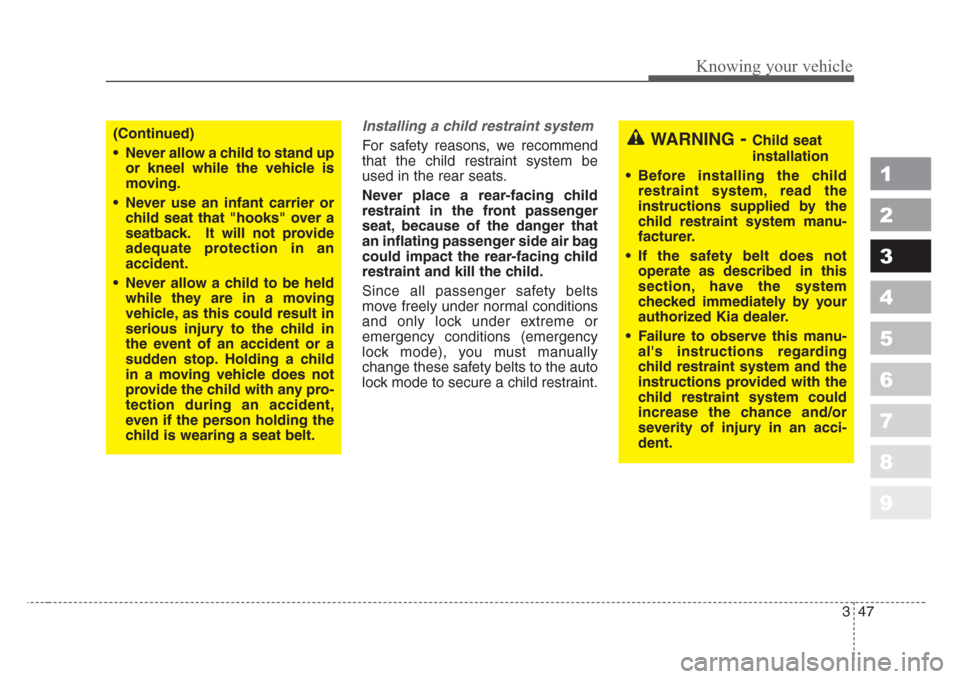
347
Knowing your vehicle
1
2
3
4
5
6
7
8
9
Installing a child restraint system
For safety reasons, we recommend
that the child restraint system be
used in the rear seats.
Never place a rear-facing child
restraint in the front passenger
seat, because of the danger that
an inflating passenger side air bag
could impact the rear-facing child
restraint and kill the child.
Since all passenger safety belts
move freely under normal conditions
and only lock under extreme or
emergency conditions (emergency
lock mode), you must manually
change these safety belts to the auto
lock mode to secure a child restraint.
(Continued)
• Never allow a child to stand up
or kneel while the vehicle is
moving.
• Never use an infant carrier or
child seat that "hooks" over a
seatback.It will not provide
adequate protection in an
accident.
• Never allow a child to be held
while they are in a moving
vehicle, as this could result in
serious injury to the child in
the event of an accident or a
sudden stop.Holding a child
in a moving veh
icle does not
provide the child with any pro-
tection during an accident,
even if the person holding the
child is wearing a seat belt.
WARNING-Child seat
installation
• Before installing the child
restraint system, read the
instructions supplied by the
child restraint system manu-
facturer.
• If the safety belt does not
operate as described in this
section, have the system
checked immediately by your
authorized Kia dealer.
•Failure to observe this manu-
al's ins
tructions regarding
child restraint system and the
instructions provided with the
child restraint system could
increase the chance and/or
severity of injury in an acci-
dent.
Page 57 of 350
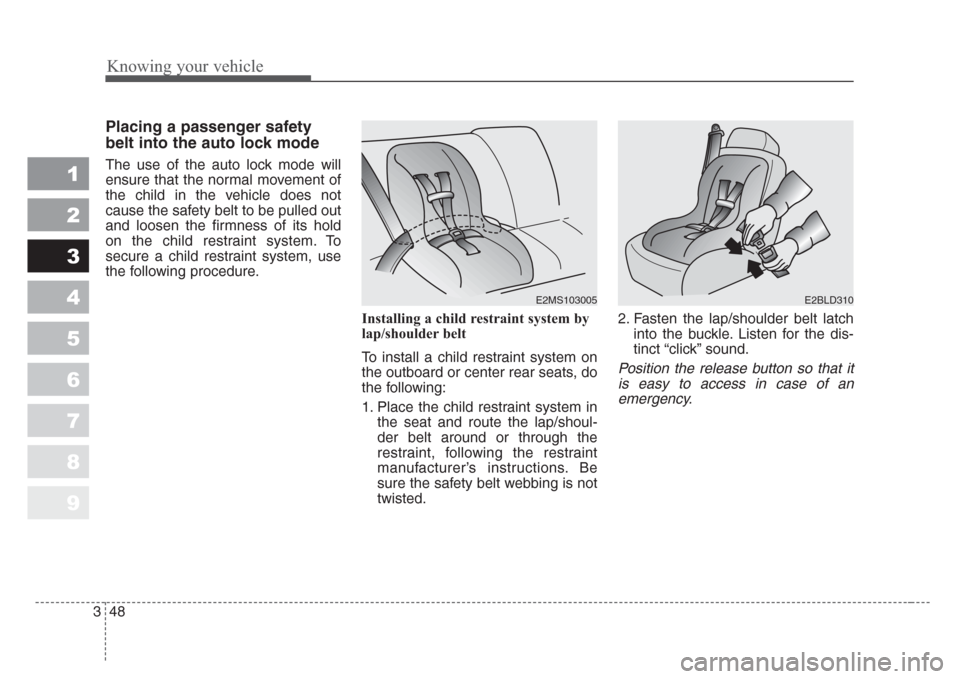
Knowing your vehicle
48 3
1
2
3
4
5
6
7
8
9
Placing a passenger safety
belt into the auto lock mode
The use of the auto lock mode will
ensure that the normal movement of
the child in the vehicle does not
cause the safety belt to be pulled out
and loosen the firmness of its hold
on the child restraint system. To
secure a child restraint system, use
the following procedure.
Installing a child restraint system by
lap/shoulder belt
To install a child restraint system on
the outboard or center rear seats, do
the following:
1. Place the child restraint system in
the seat and route the lap/shoul-
der belt around or through the
restraint, following the restraint
manufacturer’s instructions. Be
sure the safety belt webbing is not
twisted.2. Fasten the lap/shoulder belt latch
into the buckle. Listen for the dis-
tinct “click” sound.
Position the release button so that it
is easy to access in case of an
emergency.
E2MS103005E2BLD310
Page 59 of 350
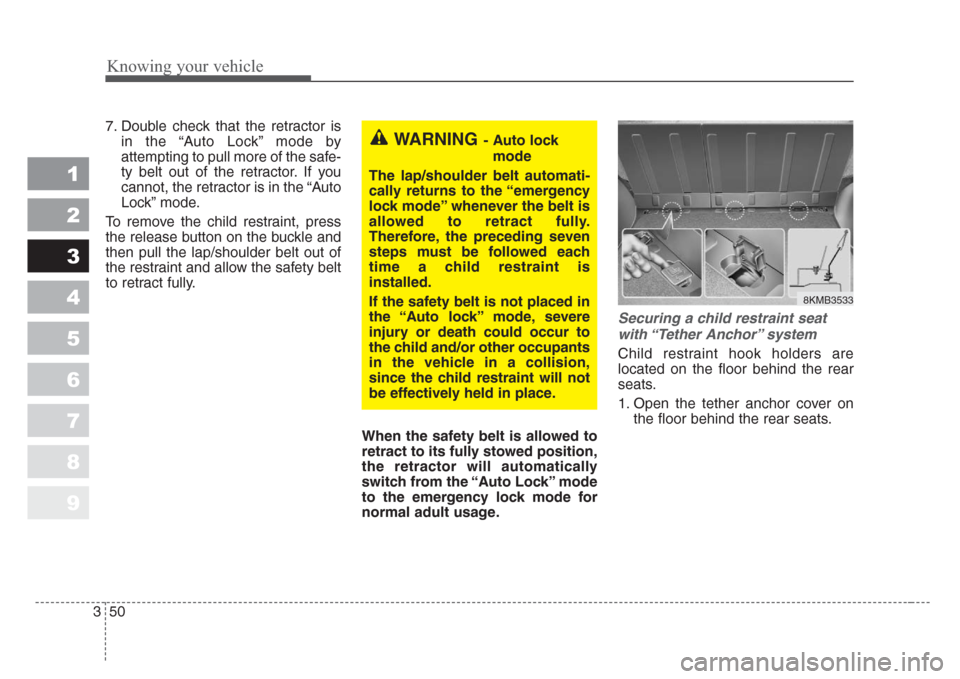
Knowing your vehicle
50 3
1
2
3
4
5
6
7
8
9
7. Double check that the retractor is
in the “Auto Lock” mode by
attempting to pull more of the safe-
ty belt out of the retractor. If you
cannot, the retractor is in the “Auto
Lock” mode.
To remove the child restraint, press
the release button on the buckle and
then pull the lap/shoulder belt out of
the restraint and allow the safety belt
to retract fully.
When the safety belt is allowed to
retract to its fully stowed position,
the retractor will automatically
switch from the “Auto Lock”mode
to the emergency lock mode for
normal adult usage.
Securing a child restraint seat
with “Tether Anchor”system
Child restraint hook holders are
located on the floor behind the rear
seats.
1. Open the tether anchor cover on
the floor behind the rear seats.
WARNING- Auto lock
mode
The lap/shoulder belt automati-
cally returns to the “emergency
lock mode”whenever the belt is
allowed to retract fully.
Therefore, the preceding seven
steps must be followed each
time a child restraint is
installed.
If the safety belt is not placed in
the “Auto lock”mode,severe
injury or death could occur to
the child and/or other occupants
in the vehicle in a collision,
since the child restraint will not
be effectively held in place.
8KMB3533
Page 60 of 350
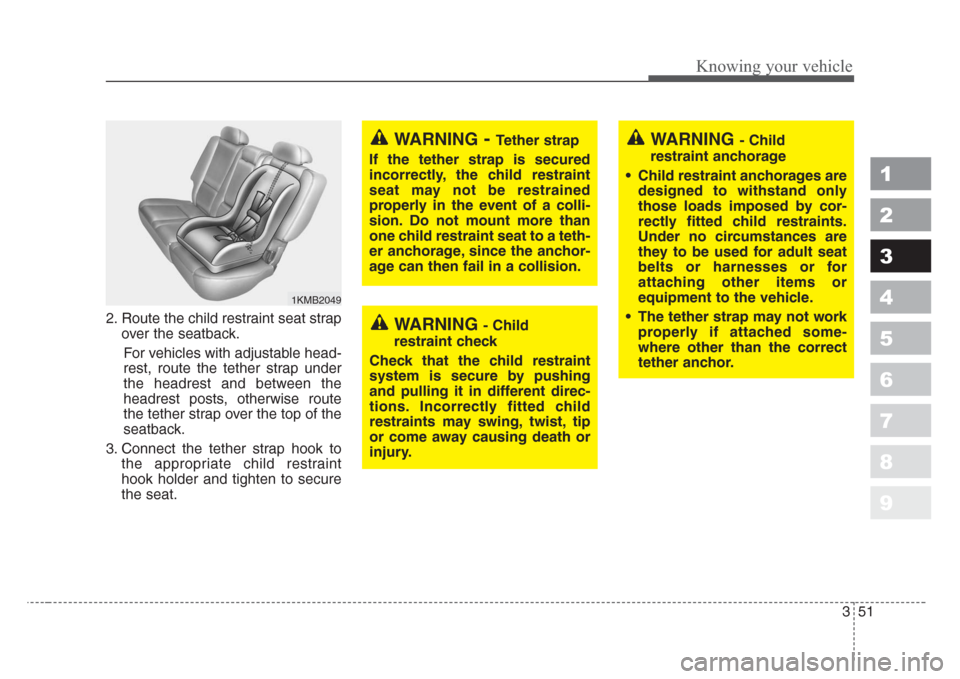
351
Knowing your vehicle
1
2
3
4
5
6
7
8
9
2. Route the child restraint seat strap
over the seatback.
For vehicles with adjustable head-
rest, route the tether strap under
the headrest and between the
headrest posts, otherwise route
the tether strap over the top of the
seatback.
3. Connect the tether strap hook to
the appropriate child restraint
hook holder and tighten to secure
the seat.
1KMB2049
WARNING-Tether strap
If the tether strap is secured
incorrectly, the child restraint
seat may not be restrained
properly in the event of a colli-
sion.Do not mount more than
one child restraint seat to a teth-
er anchorage,since the anchor-
age can then fail in a collision.
WARNING - Child
restraint check
Check that the child restraint
system is secure by pushing
and pulling it in different direc-
tions.Incorrectly fitted child
restraints may swing, twist, tip
or come away causing death or
injury.
WARNING - Child
restraint anchorage
•Child restraint anchorages are
designed to withstand only
those loads imposed by cor-
rectly fitted child restraints.
Under no circumstances are
they to be used for adult seat
belts or harnesses or for
attaching other items or
equipment to the vehicle.
• The tether strap may not work
properly if attached some-
where other than the correct
tether anchor.
Page 62 of 350
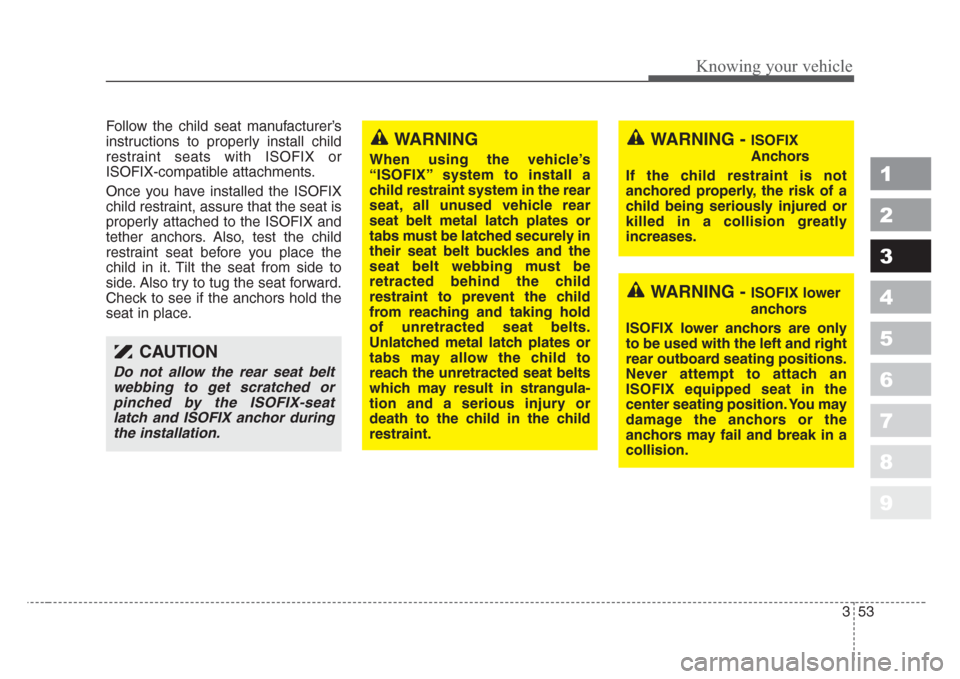
353
Knowing your vehicle
1
2
3
4
5
6
7
8
9
Follow the child seat manufacturer’s
instructions to properly install child
restraint seats with ISOFIX or
ISOFIX-compatible attachments.
Once you have installed the ISOFIX
child restraint, assure that the seat is
properly attached to the ISOFIX and
tether anchors. Also, test the child
restraint seat before you place the
child in it. Tilt the seat from side to
side. Also try to tug the seat forward.
Check to see if the anchors hold the
seat in place.
WARNING - ISOFIX
Anchors
If the child restraint is not
anchored properly, the risk of a
child being seriously injured or
killed in a collision greatly
increases.
WARNING - ISOFIX lower
anchors
ISOFIX lower anchors are only
to be used with the left and right
rear outboard seating positions.
Never attempt to attach an
ISOFIX equipped seat in the
center seating position.You may
damage the anchors or the
anchors may fail and break in a
collision.
WARNING
When using the vehicle’s
“ISOFIX”system to install a
child restraint system in the rear
seat, all unused vehicle rear
seat belt metal latch plates or
tabs must be latched securely in
their seat belt buckles and the
seat belt webbing must be
retracted behind the child
restraint to prevent the child
from reaching and taking hold
of unretracted seat belts.
Unlatched metal latch plates or
tabs may allow the child to
reach the unretracted seat belts
which may result in
strangula-
tion and a serious injury or
death to the child in the child
restraint.
CAUTION
Do not allow the rear seat belt
webbing to get scratched or
pinched by the ISOFIX-seat
latch and ISOFIX anchor during
the installation.
Page 77 of 350
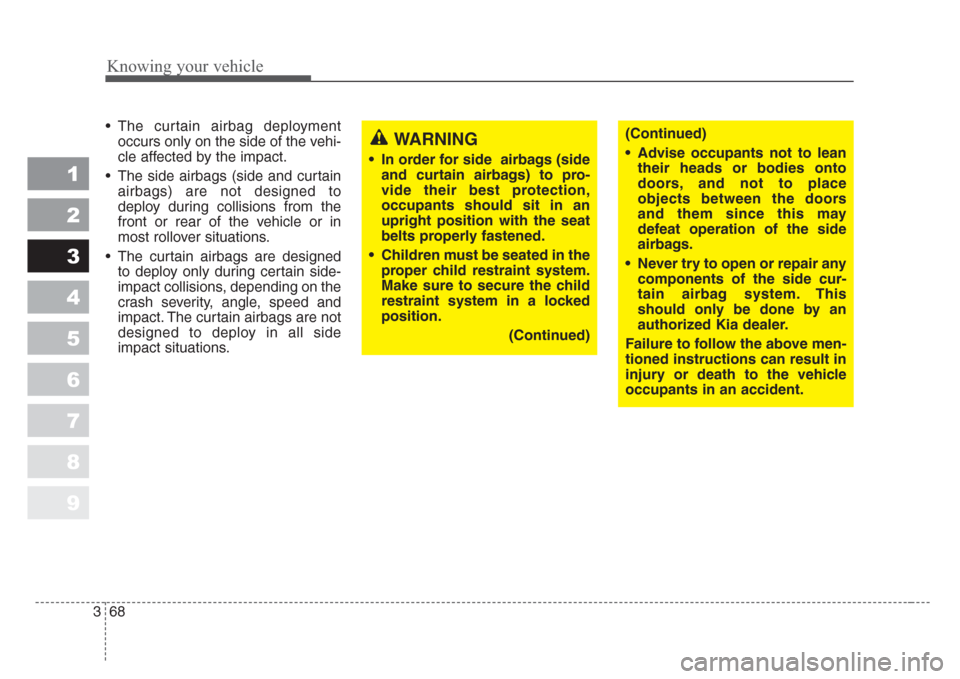
Knowing your vehicle
68 3
1
2
3
4
5
6
7
8
9
• The curtain airbag deployment
occurs only on the side of the vehi-
cle affected by the impact.
• The side airbags (side and curtain
airbags) are not designed to
deploy during collisions from the
front or rear of the vehicle or in
most rollover situations.
• The curtain airbags are designed
to deploy only during certain side-
impact collisions, depending on the
crash severity, angle, speed and
impact. The curtain airbags are not
designed to deploy in all side
impact situations.
WARNING
• In order for side airbags (side
and curtain airbags) to pro-
vide their best protection,
occupants should sit in an
upright position with the seat
belts properly fastened.
•Children must be seated in the
proper child restraint system.
Make sure to secure the child
restraint system in a locked
position.
(Continued)
(Continued)
•Advise occupants not to lean
their heads or bodies onto
doors, and not to place
objects between the doors
and them since this may
defeat operation of the side
airbags.
• Never try to open or repair any
components of the side cur-
tain airbag system.This
should only be done by an
authorized Kia dealer.
Failure to follow the above men-
tioned instructions can result in
injury or death to the vehicle
occupants in an accident.
Page 83 of 350
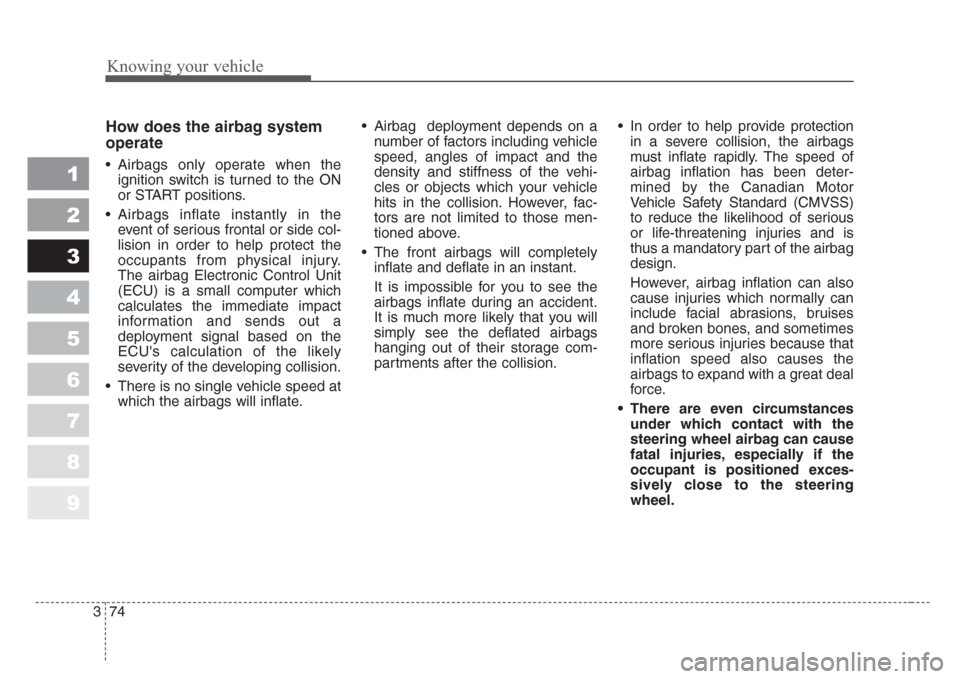
Knowing your vehicle
74 3
1
2
3
4
5
6
7
8
9
How does the airbag system
operate
• Airbags only operate when the
ignition switch is turned to the ON
or START positions.
• Airbags inflate instantly in the
event of serious frontal or side col-
lision in order to help protect the
occupants from physical injury.
The airbag Electronic Control Unit
(ECU) is a small computer which
calculates the immediate impact
information and sends out a
deployment signal based on the
ECU's calculation of the likely
severity of the developing collision.
• There is no single vehicle speed at
which the airbags will inflate.• Airbag deployment depends on a
number of factors including vehicle
speed, angles of impact and the
density and stiffness of the vehi-
cles or objects which your vehicle
hits in the collision. However, fac-
tors are not limited to those men-
tioned above.
• The front airbags will completely
inflate and deflate in an instant.
It is impossible for you to see the
airbags inflate during an accident.
It is much more likely that you will
simply see the deflated airbags
hanging out of their storage com-
partments after the collision.• In order to help provide protection
in a severe collision, the airbags
must inflate rapidly. The speed of
airbag inflation has been deter-
mined by the Canadian Motor
Vehicle Safety Standard (CMVSS)
to reduce the likelihood of serious
or life-threatening injuries and is
thus a mandatory part of the airbag
design.
However, airbag inflation can also
cause injuries which normally can
include facial abrasions, bruises
and broken bones, and sometimes
more serious injuries because that
inflation speed also causes the
airbags to expand with a great deal
force.
• There are even circumstances
under which contact with the
steering wheel airbag can cause
fatal injuries,especially if the
occupant is positioned exces-
sively close to the steering
wheel.